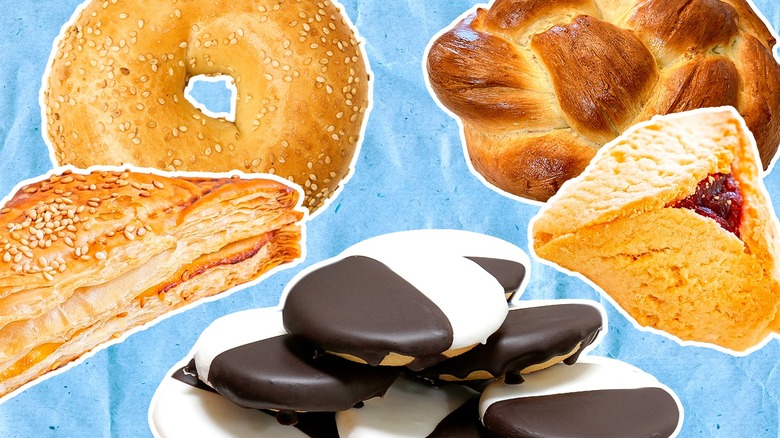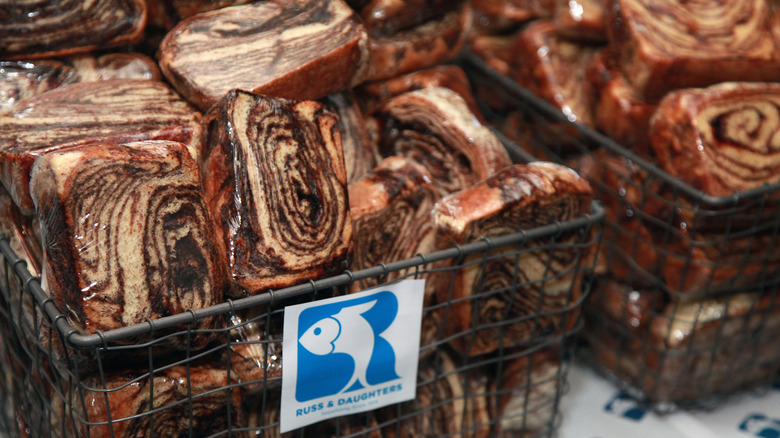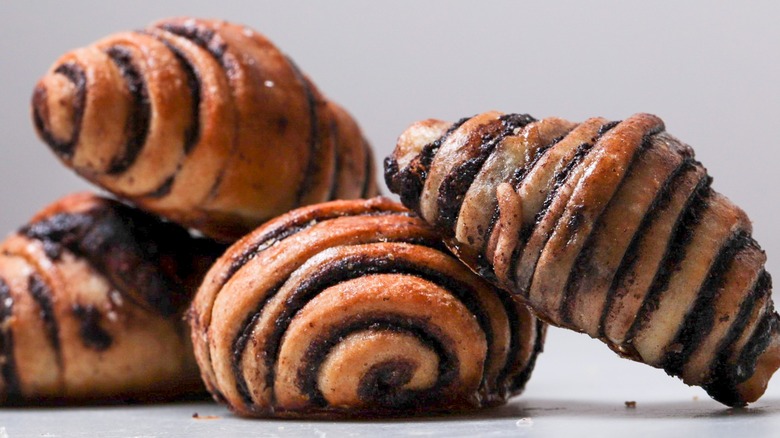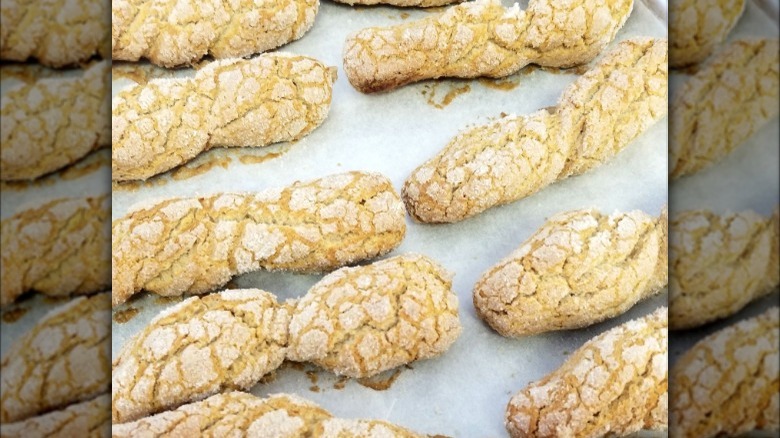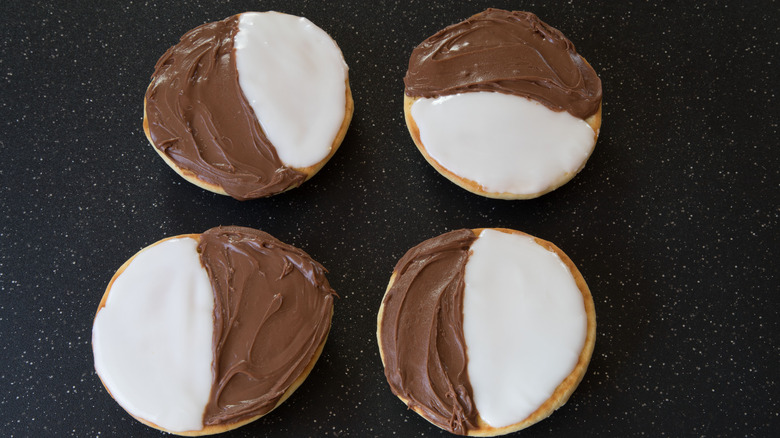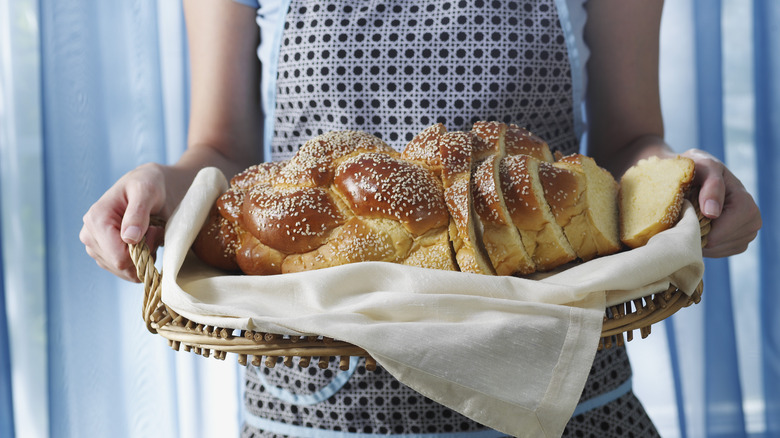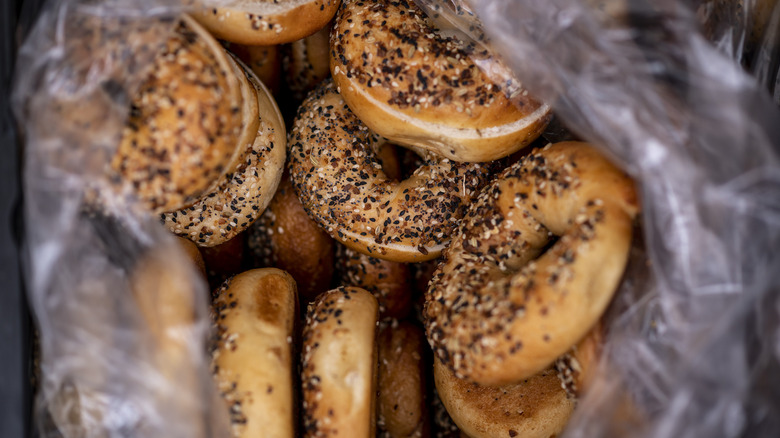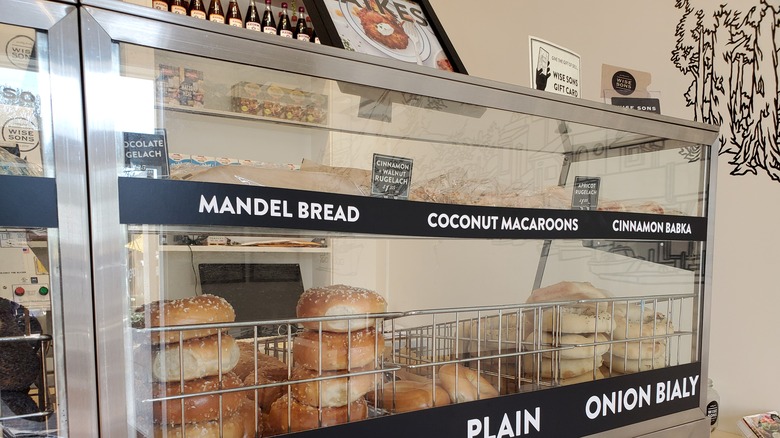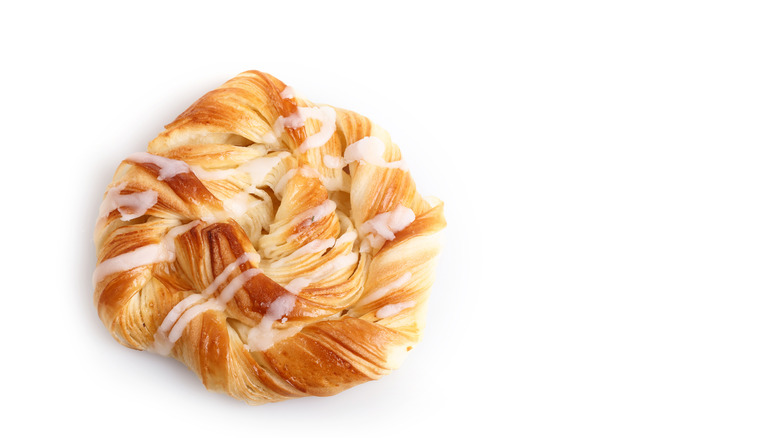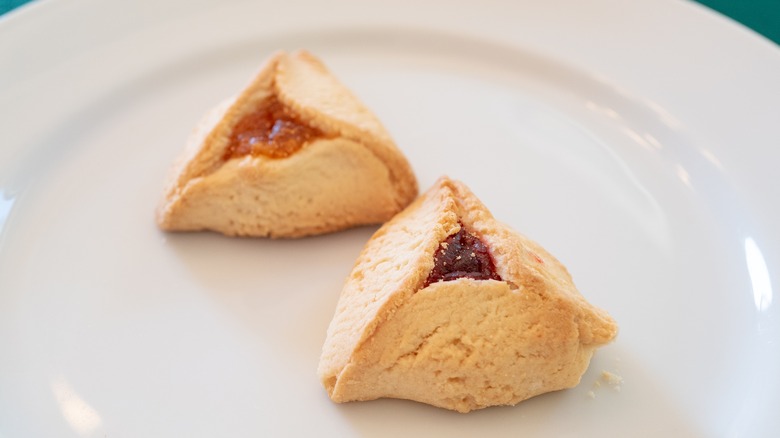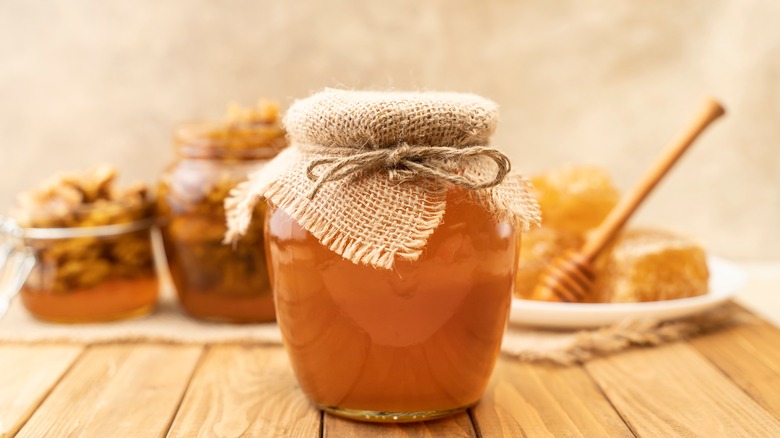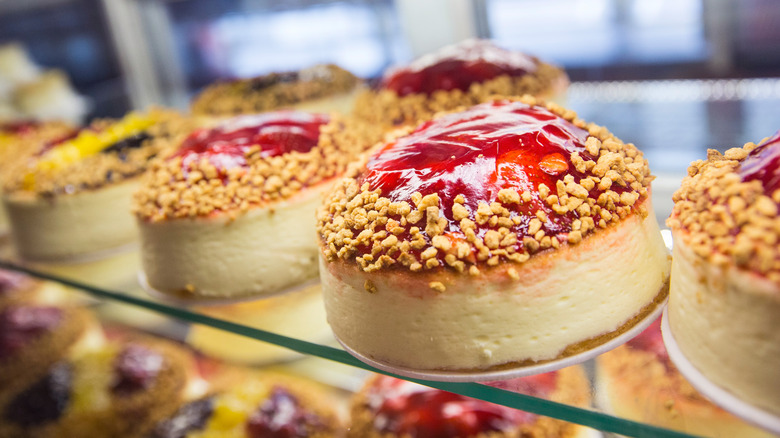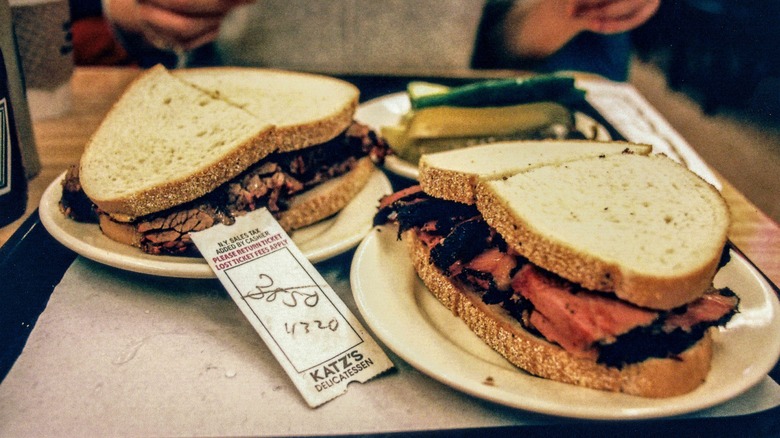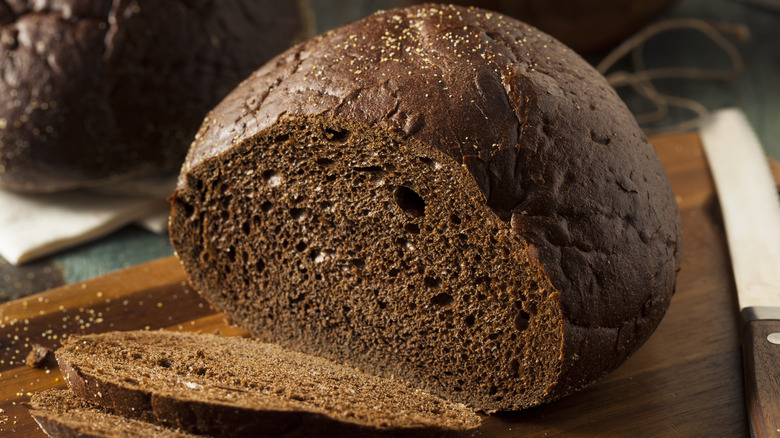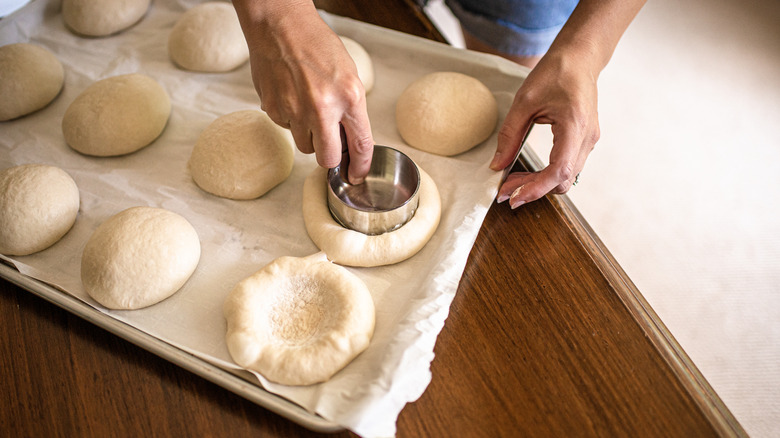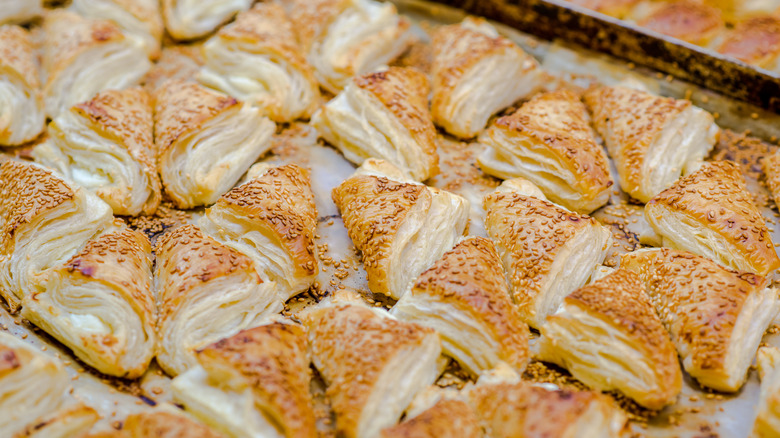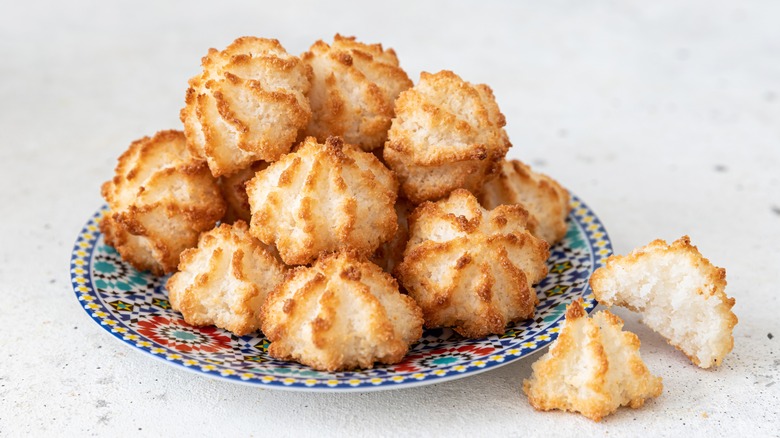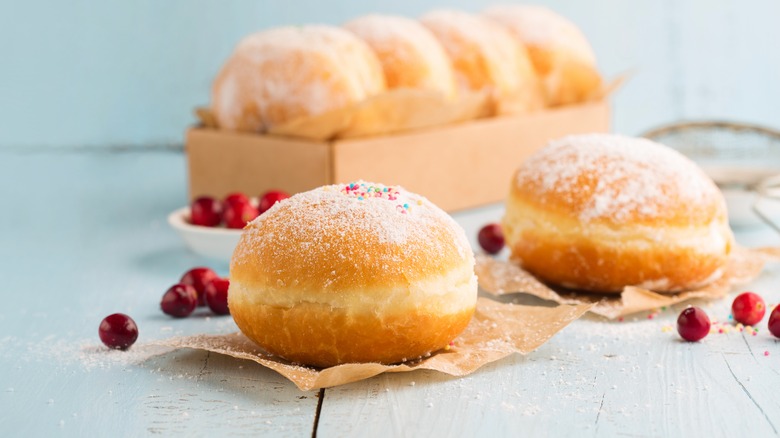17 Popular Items You'll Commonly Find At The Jewish Bakery
Even as the Jewish food scene changes and expands across the U.S. to accommodate changing tastes and ingredient costs and celebrate a wider variety of Jewish diasporas, there will always be something special about the Jewish bakery. The familiar sweet smell of fermented yeast and chocolate draws you in. The sight of bulbous and shiny, golden-plaited challahs lined up on the shelves sends a wave of calm over each customer. And, as a child, the promise of a free cookie, firmly planted in your chubby little hand, is all the motivation needed to behave.
Though still largely Ashkenazic, Jewish bakeries and restaurants are changing to reflect a blend of cultures, both of the owners and the local community, including Masa Madre in Chicago (currently closed for redesign), Breads Bakery in New York City, and Taste Bakery in Boston to name just a few. There are, however, some classic features that never go out of style. Here are a few items we'd recommend ordering during your next visit to the local Jewish bakery.
Babka
What would an excellent Jewish bakery be without a babka? The chewy, chocolaty, airy bread is a much-loved staple within the Jewish bakery and beyond it. Though there are similar types of bread throughout Eastern Europe, babka made its way to the U.S. via Jewish Polish immigrants around the late 1800s. However, many writers, including food historian Gil Marks acknowledge the twisted brioche-meets-chocolate pastry's rise to fame within American culture as a direct result of the 1994 episode of "Seinfeld," entitled "The Dinner Party" during which Jerry and Elaine debate over the superior flavor: chocolate or cinnamon babka.
In recent years we've seen babka make its way out of the dessert section, with plenty of recipes and restaurants featuring savory babka options. No matter which you choose, we can all agree, like Jerry and Elaine once said, "You can't beat a babka."
Rugelach
The name rugelach comes from Yiddish, meaning "little twists." While versions of this shape exist all over Eastern Europe, like kifli in Hungary and rogal in Poland, American-style rugelach is distinctive for two reasons. The yeasted and laminated dough commonly found in versions of rugelach outside of the United States, like in Israel and the U.K., has been replaced with cream cheese. The result is a rich, easy-to-manipulate, slightly flaky dough perfect for smearing with jam, nuts, chocolate, or whatever filling you prefer and rolling into finger-sized twists.
Though rugelach is a popular choice around the high holidays of Rosh Hashanah and Yom Kippur, it is also a year-round treat. It is also a likely contender, and a handful of other small cookies to be handed out for free to children. This is considered an unspoken policy that is still part of the culture of many old-school Jewish bakeries across America. We can't think of a better incentive to behave inside the bakery than the promise of a free cookie!
Kichel
If you're looking for a crispy, crunchy, feathery, light treat that you can eat five of in quick succession, look no further than kichel, a much-loved staple of the American Jewish bakery. The name kichel means 'cookie' in Yiddish.
Kichel, for those unfamiliar, are easily spotted by their bow tie shape and sparkly, diamond-encrusted-like coating made from granulated sugar. While the dough itself isn't very sweet, the sweet, sugar crystals coating creates a perfect balance of sweetness and texture, adding a bit of crunch to the already flaky and airy cookie. Do not be fooled by their seemingly simple look and taste; there is something extraordinary about this Jewish bakery classic.
Not just an American Jewish bakery staple, kichel is also popular amongst Jewish communities in South Africa, though they look slightly different. In South Africa, kichel or kichelach are shaped into larger, flatter cookies rather than their ubiquitous twisted U.S. version. This somewhat different shape means they can be used more like a cracker for scooping up dips or even chopped herring, as well as eaten on their own.
Black and white cookie
Even mentioning a black and white cookie evokes images of its yin-yang-like pairing of black and white smooth icing on top of the drop cake-like texture beneath. They are a quintessential Jewish American bakery classic, synonymous with the Jewish bakery and deli culture of New York City.
The Black and white cookie's origins, according to Eater, have likely been traced back to the influence of Dutch immigrants, who arrived during the 1600s and 1700s with similarly textured miniature cake traditions. The Dutch word for tiny cake also points to the Dutch influence on American culture: the Dutch word "koekje," meaning "little cake."
And, of course, if it's part of Jewish New York culture, it is no surprise that it's also been a subject of a Seinfeld episode. The famous cookie also had a cameo in season five's "The Dinner Party" episode, as Jerry and Elaine debate the cookie's meaning and symbolism.
Challah
If you were strip all of Ashkenazi Jewish baked goods back to just one symbolic food, challah would be the obvious choice. It is a bread rich with meaning and a mainstay in the weekly celebration of Shabbat, a special weekly Jewish holiday featuring family and rest. Challah even comes with its own special prayer known as the "hamotzi."
Challah is traditionally braided or made round for special holidays like Rosh Hashanah. This wonderfully chewy yeasted bread is enriched with eggs and often topped with sesame or poppy seeds. Due to its amount of proving time, it is also a time-consuming activity to make at home, especially in conjunction with busy modern life. Because of this, and challah's significance in weekly rituals for practicing Ashkenazi Jews, challah is inevitable at the bakery. No matter how tiny the Ashkenazic bakery is, there will always be challah on the shelves unless you get there too late on a Friday afternoon and it's sold out.
Bagels
Suppose you want to decipher between a good (Ashkenazic) Jewish bakery and a great one. We say the proof isn't in the pudding but in the bagels. Brought over to the U.S. by Jewish Polish immigrants in the early 1900s, an excellent fresh bagel highlights the multi-textured crisp-meets-chew that comes from boiling the rounds before baking them. Even the plain bagels should have a sweetness to them, thanks to the yeasted dough. We're also suckers for a fresh bagel slathered with scallion cream cheese with lox, pickles, and capers.
When it comes to bagels, everyone has their favorite: plain, salt, onion, sesame, poppy seed, or the king of all bagel flavors, everything (aka mishmash). So popular is the everything bagel that various celebrities have come forward to claim ownership of inventing what is considered New York City's favorite bagel.
Mandel bread or mandelbrot
Mandel bread, or mandelbrot, as it's called in Yiddish, could be considered the Jewish bakery's answer to biscotti. In fact, given its similarities, it's likely the food came out of Italian or Sephardic traditions. Mandel bread is crunchy, crumbly, not overly sweet, and perfect when dunked into a cup of hot coffee. It makes the perfect anytime treat.
Mandelbrot was a popular food within Ashkenazic communities across Eastern Europe due to its long shelf life and easy storage, especially while traveling. While the name in Yiddish translates to "almond bread," a wide variety of flavors are offered at the bakery, including almond and other nuts, chocolate, and dried fruits. Like biscotti, which means "twice baked" according to its Latin root, mandel bread also goes through two bakes to create the crunchy, firm texture that makes them so satisfying, easy to store, and the perfect accompaniment to a cup of coffee or tea.
Cheese danish
We love it when happy accidents in the kitchen result in a much-loved classic, like the cheese danish. The first action that led to the creation of the beloved danish was a happy accident in the early 17th century. A French baker did what all cooks, professionals, and ammeter have done before: He forgot to add an ingredient! To make up for it, he folded the missing butter into the flour to create the classic flaky dough we now know as puff pastry. The pastry was such a success it began to make its way across Europe.
Many years later, a labor strike in Denmark in 1850 resulted in the hiring of international bakers, including bakers from Austria who brought their own heritage into the Danish bakeries and cemented the new products within the culture. The once-Austrian pastry eventually became known as the 'Danish,' making its way to New York via Danish immigrants in the early 20th century, and the Jewish Danish was born. Filled with lightly sweetened cream cheese or farmer's cheese, sometimes accompanied by a fruit jam filling, these are now a classic Jewish bakery staple.
Hamantaschen
Hamantaschen are small, triangular-shaped galettes, often filled with options like poppyseed, jam, or chocolate. Like many other Jewish foods, they, too, have a symbolic significance. They are usually eaten during the springtime celebration of Purim.
The delicious shortcrust-filled cookie represents the antagonist, Haman, in the story of Purim. The name is a combination of three words: "Hamen," "mohn," which means poppyseed in German, and "taschen," which means pocket. Some say hamantaschen represent his infamous hat, which may or may not be historically accurate. Others think the cookie's name and shape represent his pockets, filled with bribery money. No matter the exact origins of the cookie's representation, hamentashen are a Jewish bakery favorite and are often baked year-round.
Honey cake
Once referred to as "the Jewish fruitcake" by Marcy Goldman during an interview for NPR's The Salt, honey cake is an old Ashkenazic baked good and a classic Jewish bakery item. This traditional cake, laden with honey and traditionally flavored with clove and other warming spices, is eaten symbolically in hopes of a sweet New Year during Rosh Hashanah. However, a honey cake can be appreciated year-round and in many different (read: less dense) forms. Green's Bakery in Brooklyn thinks so, too, offering their rich honey cake year-round alongside other classics on this list like babka and rugelach.
Goldman's reference to a fruitcake indicates the sheer heft that honey cake can encompass, as was the trend in 12th-century Italy, where this treat gets its roots. Later, in Germany, the cake took on its Yiddish name "lekach" meaning honey cake. Honey cakes were also made and given as rewards for new Torah students, alongside pure honey, during Medieval times, a metaphor likening the Torah's teachings to a sweet, rich taste.
Cheesecake
There's nothing quite like the first bite of a freshly sliced piece of baked cheesecake. That triangular-sized tip holds the perfect ratio of the cheesecake's best attributes: The crumbly, buttery graham cracker crust and the silky, creamy, sweet-meets-tangy filling. Cheesecake and other dairy-rich items like blintzes and rugelach have long since endeared themselves to various Jewish diasporas. There's even a holiday that honors the significance of milk, amongst other things, known as Shavuot, where it is customary to eat cheesecake.
Cheesecake has been around for a very long time, with a record of it being fed to athletes during the first Olympic Games! It has since made its way through many cultures, including Palestine during Greek occupation, Rome, and Europe. However, it's practically impossible not to associate it with the Jewish bakery when it comes to present-day baked cheesecake.
Rye bread
Order nearly any sandwich at the Jewish deli, and you have a 50 percent chance of uttering the phrase "on rye." Therefore, it makes good sense that rye is a classic offering at many Jewish bakeries. Jewish rye differs from some of the darker, denser rye varieties prevalent in German, Scandinavian, and Nordic countries.
Often associated with the fennel-tasting caraway seeds, Jewish rye also tends to be lighter in color than some of the similarly named German or Scandinavian ryes. Taking inspiration from the lighter varieties found in Poland and Ukraine that incorporated wheat into the dough, this lighter variety often was more cost-effective, making it easier to absorb into American culture, especially post-war. The lighter versions, more commonly placed at the Jewish deli, can also be purchased fresh from the bakery; you can even ask for them to be sliced right on sight, perfect for freezing.
Pumpernickel
Originally from Germany, pumpernickel is a variety of rye bread known for its malty sweet, sour flavor and rich brown color. Pumpernickel bread in the U.S. tends to be lighter than its European counterpart. It is made from coarse rye and wheat flour mixed with dry yeast rather than just rye flour and sourdough leavening. However, it's still a hearty bread. Though derived from the same grain, pumpernickel is different from Jewish rye; it has a darker, richer flavor with a notable absence of caraway seeds.
Pumpernickel is an excellent base for a hearty toasted Reuben sandwich, another Ashkenazi classic made of pastrami, sauerkraut, melted Swiss cheese, and Russian dressing. It is also perfect for simply toasting a slathering with butter or cream cheese or topping with eggs and lox for a simple but effective breakfast.
Bialys
Though it might be a bit harder to find than a bagel, anyone who undertakes the noble quest for the bialy at the Jewish bakery will be rewarded with a chewy, baked-onion-filled treat! Though often lumped into the same category as bagels, bialys are their own entity.
Bialys, like the bagel, are also thought to be from Poland. However, bialys are only baked instead of undergoing the double cooking method of their carbohydrate cousin. This means the texture of a bialy will differ from a bagel, offering less chew and more sourdough-like bubbles under its crust. Both bagels and bialys play well with classic toppings like cream cheese, lox and capers, and tuna salad. A bialy might be the perfect solution for those looking to change their go-to bagel order.
Bourekas
Savory options can sometimes be harder to find at the Jewish bakery or any bakery. For those whose palate prefers to lean away from the sweet, we think a boureka might tick all the boxes. This hand-held pastry is often stuffed with popular vegetarian fillings like spinach and cheese or potato to adhere to kosher law.
Bourekas have become incredibly popular and commonplace in countries like Israel, making their way via a community of Sephardic Jews from Spain who escaped to Turkey during the Spanish Inquisition. The name 'boureka' is thought to reflect both Spanish and Turkish.
Bourekas can be made with either puff pastry or phyllo dough. Both versions are delicious and have an element of crispiness and flakiness. However, results will vary depending on which kind of dough is used. The combination of the flaky texture, alongside a savory, if not slightly salty, filling, might taste similar to other such pastries like spanikopita.
Macaroons
Not to be confused with the almond-based French macaron, macaroons are a coconut lover's dream, found at the local Jewish bakery. Though they've become a classic go-to dessert during the eight-day Jewish holiday Passover, their chewy texture and sweet coconut flavor are worth eating year-round. Variations can include many other fruits and nuts like raspberries, pistachios, and our favorite, chocolate-dipped! Notably, neither the coconut-based drop macaroon nor the French almond macaron contains any flour, making them both delicious options when celebrating Passover.
Interestingly, both the French macaron and the Jewish macaroon have roots in Italy before traveling first to France, then later from France to America. As food and people have always done, this cookie evolved during each relocation based on available ingredients at the time.
Sufganiyot
Sufganiyot is the Jewish answer to the doughnut. Or rather, one of the culture's answers, as many sweet, deep-fried things exist within a range of Jewish diasporas! This delicious, deep-fried dessert is eaten alongside other oil-laden foods during the celebration of Hanukkah. One trip to Israel during the festival of lights will connect you with more sufganiyot flavors and toppings than you might have ever thought possible, thanks to a combination of Ashkenazic immigrants and North African and Sephardic presence and influences. Sufganiyot are becoming an increasingly popular item stateside, too.
Like other foods on this list, including honey cake, macaroons, and even challah, sufganiyot have become a year-round offering at many Jewish bakeries, thanks to their delicious taste and high customer demand. Flavors include jelly-filled, vanilla or chocolate cream flavored, and many, many more.
